The Intel Core i9-9900KS Review: The 5 GHz Consumer Special
by Dr. Ian Cutress on October 31, 2019 10:45 AM ESTCPU Performance: Web and Legacy Tests
While more the focus of low-end and small form factor systems, web-based benchmarks are notoriously difficult to standardize. Modern web browsers are frequently updated, with no recourse to disable those updates, and as such there is difficulty in keeping a common platform. The fast paced nature of browser development means that version numbers (and performance) can change from week to week. Despite this, web tests are often a good measure of user experience: a lot of what most office work is today revolves around web applications, particularly email and office apps, but also interfaces and development environments. Our web tests include some of the industry standard tests, as well as a few popular but older tests.
We have also included our legacy benchmarks in this section, representing a stack of older code for popular benchmarks.
All of our benchmark results can also be found in our benchmark engine, Bench.
WebXPRT 3: Modern Real-World Web Tasks, including AI
The company behind the XPRT test suites, Principled Technologies, has recently released the latest web-test, and rather than attach a year to the name have just called it ‘3’. This latest test (as we started the suite) has built upon and developed the ethos of previous tests: user interaction, office compute, graph generation, list sorting, HTML5, image manipulation, and even goes as far as some AI testing.
For our benchmark, we run the standard test which goes through the benchmark list seven times and provides a final result. We run this standard test four times, and take an average.
Users can access the WebXPRT test at http://principledtechnologies.com/benchmarkxprt/webxprt/
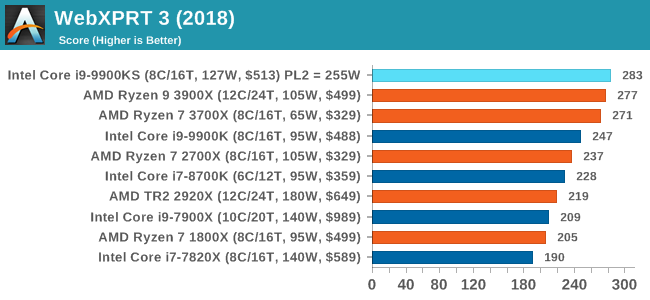
WebXPRT 2015: HTML5 and Javascript Web UX Testing
The older version of WebXPRT is the 2015 edition, which focuses on a slightly different set of web technologies and frameworks that are in use today. This is still a relevant test, especially for users interacting with not-the-latest web applications in the market, of which there are a lot. Web framework development is often very quick but with high turnover, meaning that frameworks are quickly developed, built-upon, used, and then developers move on to the next, and adjusting an application to a new framework is a difficult arduous task, especially with rapid development cycles. This leaves a lot of applications as ‘fixed-in-time’, and relevant to user experience for many years.
Similar to WebXPRT3, the main benchmark is a sectional run repeated seven times, with a final score. We repeat the whole thing four times, and average those final scores.
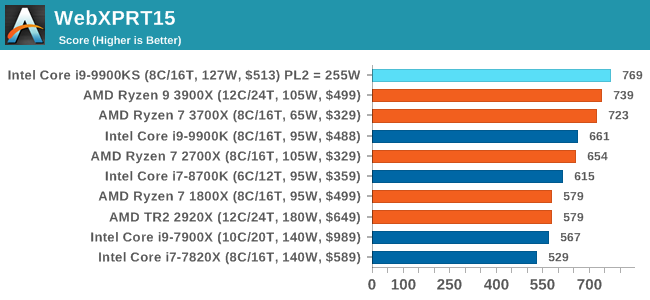
Speedometer 2: JavaScript Frameworks
Our newest web test is Speedometer 2, which is a accrued test over a series of javascript frameworks to do three simple things: built a list, enable each item in the list, and remove the list. All the frameworks implement the same visual cues, but obviously apply them from different coding angles.
Our test goes through the list of frameworks, and produces a final score indicative of ‘rpm’, one of the benchmarks internal metrics. We report this final score.
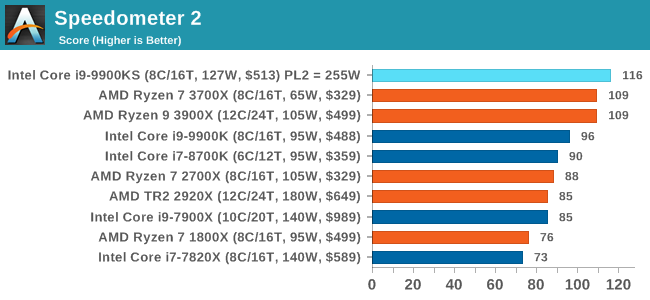
Google Octane 2.0: Core Web Compute
A popular web test for several years, but now no longer being updated, is Octane, developed by Google. Version 2.0 of the test performs the best part of two-dozen compute related tasks, such as regular expressions, cryptography, ray tracing, emulation, and Navier-Stokes physics calculations.
The test gives each sub-test a score and produces a geometric mean of the set as a final result. We run the full benchmark four times, and average the final results.
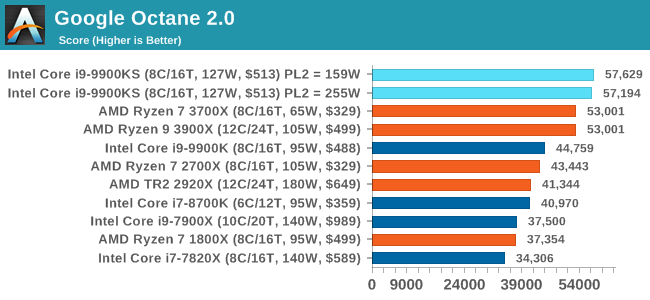
Mozilla Kraken 1.1: Core Web Compute
Even older than Octane is Kraken, this time developed by Mozilla. This is an older test that does similar computational mechanics, such as audio processing or image filtering. Kraken seems to produce a highly variable result depending on the browser version, as it is a test that is keenly optimized for.
The main benchmark runs through each of the sub-tests ten times and produces an average time to completion for each loop, given in milliseconds. We run the full benchmark four times and take an average of the time taken.
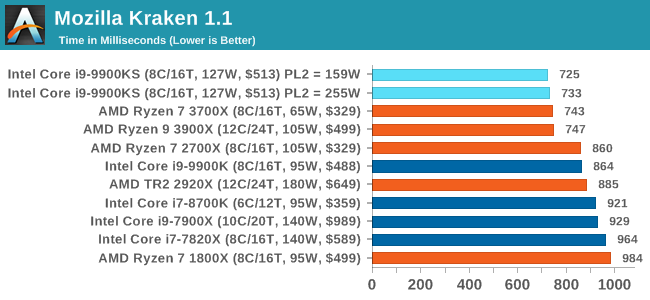
3DPM v1: Naïve Code Variant of 3DPM v2.1
The first legacy test in the suite is the first version of our 3DPM benchmark. This is the ultimate naïve version of the code, as if it was written by scientist with no knowledge of how computer hardware, compilers, or optimization works (which in fact, it was at the start). This represents a large body of scientific simulation out in the wild, where getting the answer is more important than it being fast (getting a result in 4 days is acceptable if it’s correct, rather than sending someone away for a year to learn to code and getting the result in 5 minutes).
In this version, the only real optimization was in the compiler flags (-O2, -fp:fast), compiling it in release mode, and enabling OpenMP in the main compute loops. The loops were not configured for function size, and one of the key slowdowns is false sharing in the cache. It also has long dependency chains based on the random number generation, which leads to relatively poor performance on specific compute microarchitectures.
3DPM v1 can be downloaded with our 3DPM v2 code here: 3DPMv2.1.rar (13.0 MB)
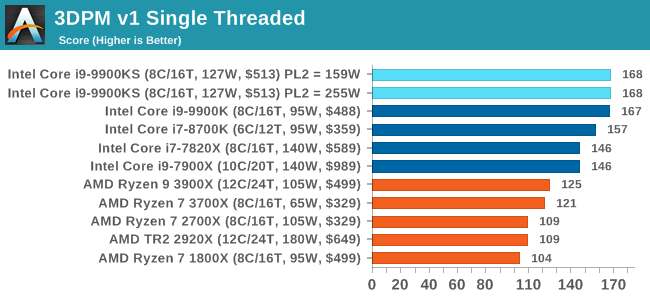
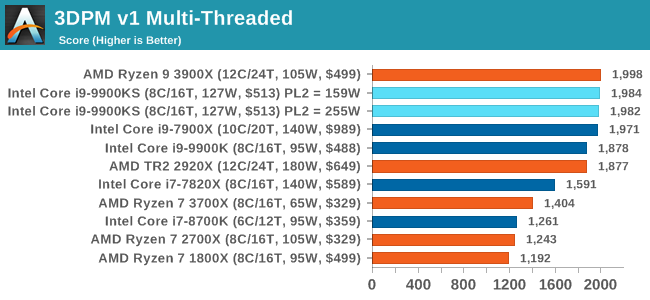
x264 HD 3.0: Older Transcode Test
This transcoding test is super old, and was used by Anand back in the day of Pentium 4 and Athlon II processors. Here a standardized 720p video is transcoded with a two-pass conversion, with the benchmark showing the frames-per-second of each pass. This benchmark is single-threaded, and between some micro-architectures we seem to actually hit an instructions-per-clock wall.
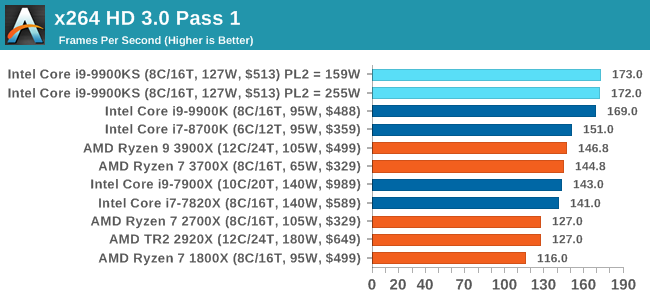











235 Comments
View All Comments
amnesia0287 - Saturday, November 16, 2019 - link
Can’t tell if playing stupid or srs.The IPC advantage is 10%, the clock speed advantage is >10%.
Intel chips all the cores are able to boost to the same levels. AMD chips now have varying spec cores and only the best 1-2 hit the advertised speeds and only when there are only a few threads running. If you are doing heavy multitasking, most of the AMD cores will be dramatically slower than those of the 9900ks.
That said the AMD chips still have a number of other advantages such as more pci bandwidth and no tiny DMI bottleneck. Lower cost, lower power use and generally more cores.
Right now it really comes down to what you plan to use it for. There is little doubt AMD is in a better spot right now, but it remains to be seen if they can hold it past 2021 as intel transitions to 7nm and MCM.
Korguz - Saturday, November 16, 2019 - link
" The IPC advantage is 10%, the clock speed advantage is >10%." and WHY do you think intel has the lead, even barely, in some cases. because of the clock speed advantage. Intel's cpus NEED this advantage just to keep the performance they have. think about it, a LOWER clocked chip over all is performing about the same,( depending on usage ) and in some cases better, then the higher clocked equivalents clock these chips the same, and i bet the story would be quite different. " Intel chips all the cores are able to boost to the same levels " at quite a bit more power usage too." 2021 as intel transitions to 7nm and MCM. " more like IF intel can transition to 7nm by then, look how long it has taken them to get to 10nm..
shaolin95 - Monday, November 11, 2019 - link
*cough, cough* butthurt AMD fanboy detected *cough, cough*Qasar - Monday, November 11, 2019 - link
how so ??? seems there are more intel fans but hurt lately...peevee - Friday, November 1, 2019 - link
:)Funny, I had exactly the same thought.
But honestly, for many real world uses (games etc) 4 cores at even faster frequency would be even better. Physically separated on the die as far as possible (in the corners) by huge amount of shared L3.
I guess 5GHz base/6GHz turbo is not out of the question within the same TDP with liquid cooling.
eva02langley - Thursday, October 31, 2019 - link
A joke of a CPU. How can this cost more than a 3900x?eva02langley - Thursday, October 31, 2019 - link
Not to mention that with the price gouging, you are almost near the MSRP of the 3950x.prophet001 - Thursday, October 31, 2019 - link
People want this for clock speed.12 slow cores aren't helpful if you need a few fast ones.
eva02langley - Thursday, October 31, 2019 - link
AHAHAHA... okay, we have a blind fanboy here. Do you know anything about IPC? This CPU get destroyed in EVERYTHING except old games running outdated engines at 1080p. SO unless you buy this with a 2080 TI and a 240Hz 1080p monitor, you are not going to benefit from it.Basically, with a budget, the 9900KS is a waste of money, period. The money you save buying a 3700x and investing in your GPU will give you some serious gaming performances increase.
xenol - Thursday, October 31, 2019 - link
Honestly anything more than a midrange CPU and GPU is a waste of money for most people.